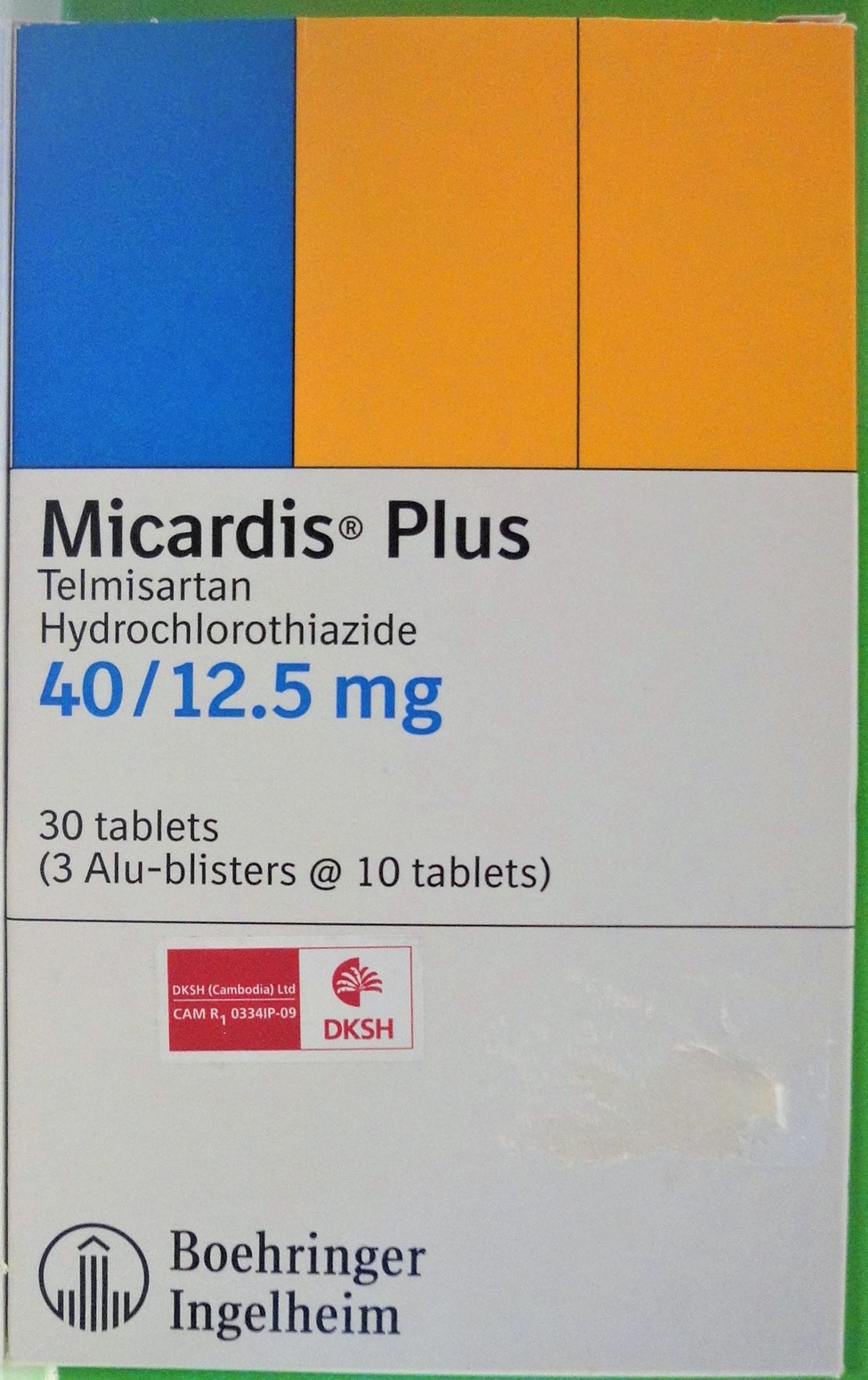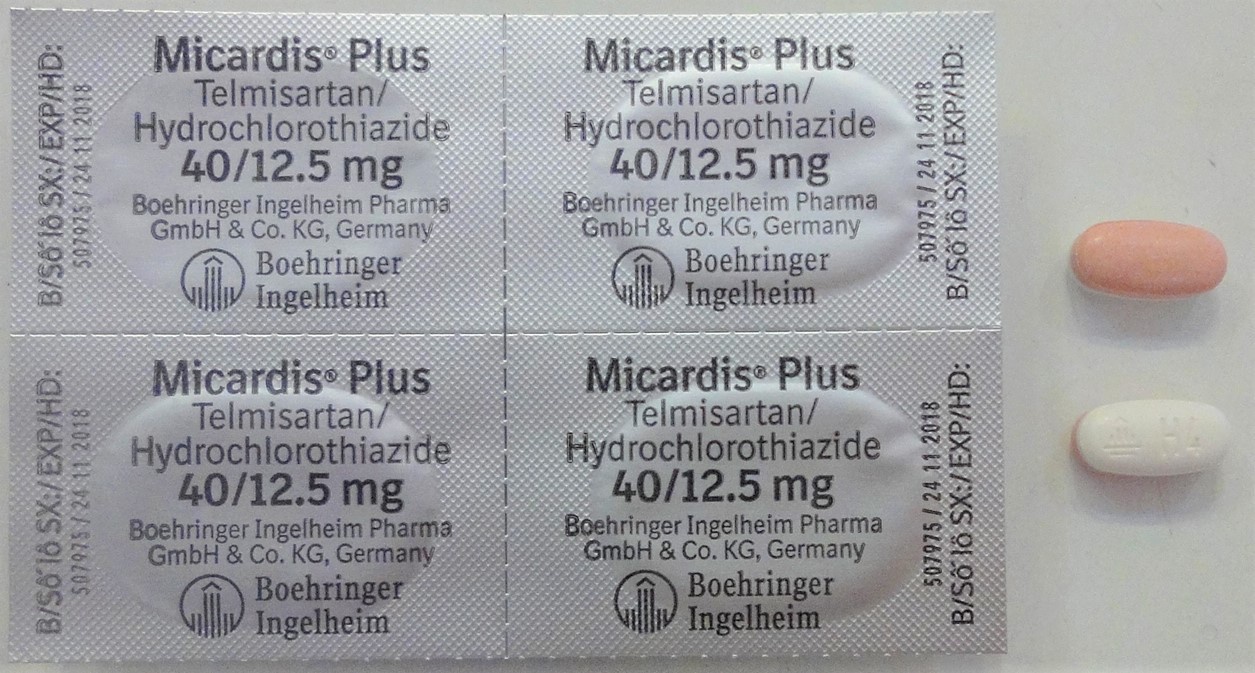MICARDIS PLUS Tablet
ក្រុមហ៊ុនផលិតឱសថ:
Boehringer Ingelheim Ellas A.E, Greece
ក្រុមហ៊ុនចែកចាយឱសថនៅប្រទេសកម្ពុជា:
DKSH


- សារធាតុសកម្ម
- ប្រសិទ្ធិភាពព្យាបាល និង កម្រិតប្រើប្រាស់
- ហាមប្រើ
- ផលរំខាន
- អន្តរប្រតិកម្ម
- ស្ត្រីមានផ្ទៃពោះ និង ស្ត្រីបំបៅដោះកូន
- ការប្រុងប្រយ័ត្នជាពិសេស
- សកម្មភាពឱសថ បរិយាយប័ណ្ណឱសថ
-
សារធាតុសកម្ម
1. MICARDIS PLUS 40mg/12.5mg Tablet:
Telmisartan 40mg, Hydrochlorothiazide 12.5mg
2. MICARDIS PLUS 80mg/12.5mg Tablet:
Telmisartan 80mg, Hydrochlorothiazide 12.5mg
3. MICARDIS PLUS 80mg/25mg Tablet:
Telmisartan 80mg, Hydrochlorothiazide 25mg
-
ប្រសិទ្ធិភាពព្យាបាល និង កម្រិតប្រើប្រាស់
គុណភាពព្យាបាល
ឱសថនេះប្រើសំរាប់ព្យាបាលជំងឺលើសសំពាធឈាមខ្លាំង ដែលការព្យាបាលដោយ Telmisartant 1មុខ ឬ hyperchlorothiazide មិនអាចគ្រប់គ្រងសំពាធឈាមបាន។
កំរិតនិងរបៀបប្រើ
- សំរាប់មនុស្សពេញវ័យ៖ ឱសថនេះត្រូវលេបតែ 1ដង រាល់ថ្ងៃ។ កំរិតប្រើឱសថនេះមានដូចខាងក្រោម៖
・Micardis Plus 40/12.5mg អាចប្រើចំពោះអ្នកជំងឺ ដែលសំពាធឈាមមិនអាចបញ្ចុះបានដោយការប្រើ Micardis 40mg ឬ Hydrochlorothiazide តែមួយមុខ។
・Micardis Plus 80/12.5mg អាចប្រើចំពោះអ្នកជំងឺ ដែលសំពាធឈាមមិនអាចបញ្ចុះបានដោយការប្រើ Micardis 80mg ឬ Micardis Plus 40/12.5mg។
・Micardis Plus 80/25mg អាចប្រើចំពោះអ្នកជំងឺ ដែលសំពាធឈាមមិនអាចបញ្ចុះបានដោយការប្រើ Micardis Plus 80/12.5mg ឬ ចំពោះអ្នកជំងឺធ្លាប់ព្យាបាលគ្មានប្រសិទ្ធិភាពពីមុនមកជាមួយ Telmisartant និង Hydrochlorothiazide ដោយប្រើដាច់ដោយឡែកពីគ្នា។
・ជាទូទៅ ប្រសិទ្ធិភាពក្នុងការបញ្ចុះសំពាធឈាមអតិបរមារបស់ Micardis Plus អាចឈានដល់ 4 ទៅ 8សប្ដាហ៍ បន្ទាប់ពីការចាប់ផ្ដើមនៃការព្យាបាល។
・នៅពេលចាំបាច់ គេអាចប្រើឱសថ Micardis Plus ជាមួយក្រុមឱសថបញ្ចុះសំពាធឈាមដទៃទៀតបាន។
・អាចលេបបានជាមួយអាហារ ឬដោយគ្មានអាហារ។
- សំរាប់អ្នកជំងឺខ្សោយតម្រងនោម: ដោយសារសារធាតុផ្សំ Hydrochlorothiazide, Micardis Plus មិនត្រូវបានណែនាំ អោយប្រើចំពោះអ្នកជំងឺដែលខូចមុខងារតម្រងនោមធ្ងន់ធ្ងរ (កាលណាកំរិត Creatinine ទាបជាង 30ml/min)។
- សំរាប់អ្នកជំងឺឈឺថ្លើម: កំរិតដែលណែនាំអោយប្រើមិនត្រូវលើសពី Micardis Plus 40/12.5mg លេបតែ 1ដង ប្រចាំថ្ងៃ។
- សំរាប់មនុស្សចាស់: មិនមានកំណត់កំរិតប្រើ។
- សំរាប់កូនក្មេងនិងក្មេងជំទង់: Micardis Plus មិនត្រូវបានណែនាំអោយប្រើចំពោះកូនក្មេង និងក្មេងជំទង់ អាយុក្រោម18ឆ្នាំ។Treatment of essential hypertension.
As fixed dose combination MICARDIS PLUS is indicated in patients whose blood pressure is not adequately controlled on telmisartan or hydrochlorothiazide alone.
Dosage
Adults
MICARDIS PLUS should be taken once daily. The dose of telmisartan could be up-titrated before switching to MICARDIS PLUS. Direct change from monotherapy to the fixed combinations may be considered.
- MICARDIS PLUS 40/12.5 mg may be administered in patients whose blood pressure is not adequately controlled by MICARDIS 40mg or by hydrochlorothiazide.
- MICARDIS PLUS 80/12.5 mg may be adminsitered in patients whose blood pressure is not adequately controlled by MICARDIS 80 mg or by MICARDIS PLUS 40/12.5 mg.
- MICARDIS PLUS 80/25 mg may be administered in patients whose blood pressure is not adequately controlled by MICARDIS PLUS 80/12.5 mg or patients who habe been previously stabilised on telmisartan and hydrochlorothiazide given separately.
The maximum antihypertensive effect is generally attained with MICARDIS PLUS 4-8 weeks after the start of treatment.
When necessary, MICARDIS PLUS may be administered with another antihypertensive drug.
In patients with severe hypertension treatment with telmisartan at doses up to 160mg alone and in combination with hydrochlorothiazide 12.5-25mg may daily was well tolerated and effective.
MICARDIS PLUS may be taken with or without food.
Renal impairment
Due to the hydrochlorothiazide component, MICARDIS PLUS should not be used in patients with severe renal dysfunction (creatinine clearance <30mL/min). Loop diuretics are preferred to thiazides in this population. Experience in patients with mild to moderate renal impairment is modest but has not suggested adverse renal effects and dose adjustment is not considered necessary. Periodic monitoring of renal function is advised.
Hepatic impairment
In patients with mild to moderate hepatic impairment the posology should not exceed MICARDIS PLUS 40/12.5 mg once daily. MICARDIS PLUS is not indicated in patients with severe hepatic impairment. Thiazides should be used with caution in patients with impaired hepatic function.
Elderly
No dosage adjustment is necessary.
Children and adolescents
Safety and efficacy of MICARDIS PLUS have not been established in children and in adolescents up to 18 years.
-
ហាមប្រើ
ហាមប្រើ៖ ឱសថនេះត្រូវហាមប្រើដូចខាងក្រោម៖
- អ្នកជំងឺងាយមានប្រតិកម្មជាមួយនឹងសារធាតុផ្សំណាមួយនៃឱសថនេះ
- ស្ត្រីមានផ្ទៃពោះនៅត្រីមាសទី2 និង ទី3
- ស្ត្រីបំបៅកូនដោយទឹកដោះ
- អ្នកជំងឺកើតលឿង និង ជំងឺស្ទះផ្លូវទឹកប្រមាត់
- អ្នកជំងឺឈឺថ្លើមធ្ងន់ធ្ងរ
- អ្នកជំងឺខូចតម្រងនោមធ្ងន់ធ្ងរ (កាលណាកំរិត creatinine ទាបជាង 30ml/min)
- ជំងឺខ្វះជាតិប៉ូតាស្យូម និងលើសកាល់ស្យូមក្នុងឈាមដេលពិបាកព្យាបាល។Hypersensitivity to the active ingredient, to any of the excipients, or to other sulphonamide-derived substances (hydrochlorothiazide is a sulphonamide-derived substance).
- Pregnant women
- Lactation
- Cholestasis and biliary obstructive disorders
- Severe hepatic impairment
- Severe renal impairment (creatinine clearance <30mL/min)
- Refractory hypokalaemia, hypercalcaemia
- The concomitant use of MICARDIS PLUS with aliskiren is contraindicated in patients with diabetes mellitus or renal impairment (GFR<60ml/min/1.73m2)
In case of rare hereditary conditions that may be incompatible with an excipient of the product the use of the product is contraindicated.
-
ផលរំខាន
ផលរំខានរួមមាន៖
- កើនឡើង អង់ហ្ស៊ីមក្នុងថ្លើម, uric acid, creatinine
- បេះដូងដើរញាប់
- ខ្យល់គរ ធីងធោង គេងមិលក់ វិបត្តិដំណេក
- ស្រវាំងភ្នែក ព្រិលភ្នែកបណ្ដោះអាសន្ន
- វិលមុខ
- ស្ងួតមាត់ រាក ក្អួត ទល់លាមក ហើមពោះ ឈឺពោះ មិនរំលាយអាហារ។ល។
- មុខងារថ្លើមមិនប្រក្រតី
- កន្ទួលរមាស់ ប្រទាលត្រអាក។ល។
- មុននឹងប្រើឱសថនេះ ត្រូវពិគ្រោះជាមួយគ្រូពេទ្យជំនាញ។- Investigations: Increase in creatinine, increase in liver enzymes, increase in blood creatine phosphokinase, increase in uric acid
- Cardiac disorders: Cardiac arrhythmias, tachycardia
- Nervous system disorders: Syncope/faint, dizziness, paraesthesia, sleep disturbances, insomnia
- Eye disorders: Abnormal vision, transient blurred vision
- Ear and labyrinth disorders: Vertigo
- Respiratory, thoracic and mediastinal disorders: Respiratory distress (including pneumonitis and pulmonary oedema), dyspnoea
- Gastrointestinal disorders: Diarrhoea, dry mouth. flatulence, abdominal pain, constipation, dyspepsia, vomiting, gastritis
- Hepato- biliary disorders: Abnormal hepatic function/liver disorder
- Skin and subcutaneous tissue disorders: Angioedema (with fatal outcome), erythema, pruritus, rash, sweating increased, urticaria
- Musculoskeletal, connective tissue and bone disorders: Back pain, muscle spasm, myalgia, arthralgia, leg pain, cramps in legs
- Metabolism and nutrition disorders: Hypokalaemia, hyponatraemia, hyperuricaemia
- Infections and infestations: Bronchitis, pharyngitis, sinusitis
- Immune system disorders: Exacerbation or activation of systemic lupus erythematosus
- Vascular disorders: Hypotension (including orthostatic hypotension)
- General disorders and administration site conditions: Chest pain, influenza-like symptoms, pain
- Reproductive system and breast disorders: Impotence
- Psychiatric disorders: Anxiety, depression
-
អន្តរប្រតិកម្ម
អន្តរកម្មឱសថ
- ការប្រើបញ្ចូលគ្នារវាង Micardis Plus និង Lithium អាចបង្កើនគ្រោះថ្នាក់ នៃ lithium toxicity
- ការប្រើបញ្ចូលគ្នារវាង Micardis Plus និង potassium-sparing diuretics, potassium supplements, sal substitutes ត្រូវត្រួតពិនិត្យអត្រាប៉ូតាស្យូមក្នុងឈាម
- ការព្យាបាលជាមួយឱសថប្រឆាំងការរលាកក្រុម non-steroidal anti-inflammatory (NSAIDs) រួមមាន ASA, COX-2 non-selective NSAIDs អាចបណ្ដាលអោយបាត់បង់ជាតិទឹកក្នុងខ្លួនខ្លាំងចំពោះអ្នកជំងឺដែលខ្សោយតម្រងនោមធ្ងន់ធ្ងរ
- ការប្រើរួមបញ្ចូលគ្នានៃឱសថប្រឆាំងការរលាកក្រុម non-steroidal anti-inflammatory (NSAIDs) អាចបន្ថយការបញ្ចុះទឹកនោម បន្ថយកំរិតសូដ្យូមក្នុងទឹកនោម និង ប្រសិទ្ធិភាពបញ្ចុះសំពាធឈាម (antihypertensive effects) របស់ thiazide diuretics ចំពោះអ្នកជំងឺមួយចំនួន
- Telmisartant អាចបង្កើនប្រសិទ្ធិភាពបញ្ចុះសំពាធឈាមរបស់ឱសថបញ្ចុះសំពាធឈាមផ្សេងទៀតបាន
- ឱសថមួយចំនួនដូចខាងក្រោមនេះ អាចមានអន្តរកម្មជាមួយ thiazide-diuretics នៅពេលប្រើរួមបញ្ចូលគ្នា៖ Alcohol, barbiturates, or narcotics, Antidiabetic drugs (oral agents and insulins), Metformin, Cholestyramine and colestipol resins, Digitalis glycosides, Pressor amines (e.g. noradrenaline), Nondepolarizing skeletal muscle relaxants (e.g. tubocurarine), Anticholinergic agents (e.g. atropine, biperiden), Allopurinol, Calcium salts។- Lithium
- hydrochlorothiazide
- Potassium-sparing diuretics potassium supplements, salt substitutes containing potassium levels (e.g. heparin sodium)
- Drugs affected by serum potassium disturbances, e.g. digitalis glycosides, anti-arrhythmic agents and drugs known to induce torsades de pointes.
- NSAIDs including ASA at anti-inflammatory dosage regimens, COS-2 inhibitors and non-selective NSAIDs.
- Other anti-hypertensive
- Co-administration of telmisartan did not result in a clinically significant interaction with digoxin, paracetamol, simvastatin and amlodipine.
- Ramipril
- Alcohol, barbiturates, or narcotics
- Antidiabetic drugs (oral agents and insulins)
- Metformin
- Cholestyramine and colestipol resins
- Digitalis glycosides
- Pressor amines (e.g. noradrenaline)
- Nondepolarizing skeletal muscle relaxants (e.g. tubocurarine)
- Treatment for gout
- Calcium salts
- Beta-blockers and diazoxide. Anticholinergic agents (e.g. atropine, biperiden). Amantadine. Cyto-toxic drugs (e.g. cyclophosphamide, methotrexate).
-
ស្ត្រីមានផ្ទៃពោះ និង ស្ត្រីបំបៅដោះកូន
ឱសថនេះត្រូវហាមប្រើចំពោះ៖
- ស្ត្រីមានផ្ទៃពោះនៅត្រីមាសទី2 និង ទី3
- ស្ត្រីបំបៅកូនដោយទឹកដោះ។Telmisartan
AngiotensinⅡreceptor antagonists must not be initiated during pregnancy.
Unless continued angiotensinⅡreceptor antagonist therapy is considered essential, patients planning pregnancy should be changed to alternative anti-hypertensive treatments which have an established safety profile for use in pregnancy.
When pregnancy is diagnosed, treatment with angiotensinⅡreceptor antagonists should be stopped immediately, and if appropriate, alternative therapy should be started.
AngiotensinⅡ receptor antagonists exposure during the second and third trimesters is known to induce human fetotoxicity (decreased renal function, oligohydramnios, skull ossification retardation) and neonatal toxicity (renal failure, hypotension, hyperkalaemia).
Unless continued angiotensinⅡreceptor antagonists therapy is considered essential, patients planning pregnancy should be changed to alternative anti-hypertensive treatments which have an established safety profile for use in pregnancy. When pregnancy is diagnosed, treatment with angiotensinⅡreceptor antagonists should be stopped immediately, and, if appropriate, alternative therapy should be started.
Should exposure to angiotensinⅡreceptor antagonists have occurred from the second trimester of pregnancy, ultrasound check of renal function and skull is recommended.
Infants whose mothers have taken angiotensinⅡreceptor antagonists should be closely observed for hypotension.
Hydrochlorothiazide
There is limited experience during pregnancy, especially during the first trimester.
Hydrochlorothiazide cross the placenta. Based on the pharmacological mechanism of action of hydrochlorothiazide its use during the second and third trimester may compromise foeto-placental perfusion and may cause foetal and neonatal effects like icterus, disturbance of electrolyte balance and thrombocytopenia.
Hydrochlorothiazide should not be used for gestational oedema, gestational hypertension or preeclampsia due to the risk of decreased plasma volume and placental hypoperfusion, without a beneficial effect on the course of the disease.
Hydrochlorothiazide should not be used for essential hypertension in pregnant women except in rare situations where no other treatment could be used.
MICARDIS PLUS is contraindicated during lactation. It is not known whether telmisartan is excreted in human milk. Animal studies have shown excretion of telmisartan in breast milk. Thiazides appear in human milk and may inhibit lactation.
-
ការប្រុងប្រយ័ត្នជាពិសេស
ការប្រុងប្រយ័ត្ន៖
ការប្រើឱសថនេះត្រូវមានការប្រុងប្រយ័ត្នដូចខាងក្រោម៖
- ស្ត្រីមានផ្ទៃពោះ មិនត្រូវប្រើពួក Angiotensine II Receptor Antagonist
- អ្នកជំងឺឈឺថ្លើម
- ជំងឺលើសឈាមដោយសារត្បៀតសរសៃបេះដូង
- ជំងឺខ្សោយតម្រងនោម និងប្ដូរក្រលៀន
- ដំណើរថយចុះសំពាធឈាមជារោគសញ្ញា តាមការព្យាបាលដោយប្រើពួកថ្នាំបញ្ចុះទឹកនោម
- សំរាប់អ្នកជំងឺទឹកនោមផ្អែម ការកំណត់កំរិត អាំងសុយលីន ឬ ក្រុមឱសថបញ្ចុះកំរិតជាតិស្ករផ្សេងទៀត គឺជាការចាំបាច់
- អតុល្យភាព អេឡិចត្រូលីត សំរាប់អ្នកជំងឺដែលទទួលការព្យាបាលដោយឱសថបញ្ចុះទឹកនោម
- អ្នកជំងឺដែលមានលក័្ខណជំងឺតំណពូជនៃភាពមិនស៊ាំជាមួយនឹងfructose
- អ្នកជំងឺដែលមានលក្ខ័ណជំងឺតំណពូជនៃភាពមិនស៊ាំជាមួយនឹង galatose
- សំរាប់អ្នកជំងឺត្បៀតសរសៃបេះដូង នៅពេលប្រើជាមួយឱសថបញ្ចុះសំពាធឈាមណាមួយផ្សេងទៀត ដែលធ្វើអោយសំពាធឈាមធ្លាក់ចុះខ្លាំង អាចបណ្ដាលអោយក្រិនសាច់ដុំបេះដូងឬស្ត្រូក។- Hepatic impairment
- Renovascular hypertension
- Renal impairment and kidney transplant
- Intravascular volume depletion
- Dual blockade of the renin-angiotensin-aldosterone system
- Other conditions with stimulation of the renin-angiotensin-aldosterone system
- Primary aldosteronism
- Aortic and mitral valve stenosis, obstructive hypertrophic cardiomyopathy
- Metabolic and endocrine effects
- Electrolyte imbalance
- Sorbitol
- Diabetes mellitus
- Lactose
- Other (Excessive reduction of blood pressure in patients with ischaemic cardiopathy or ischaemic cardiovascular disease could result in a myocardial infarction or stroke.)
- General (Hypersensitivity reactions to hydrochlorothiazide may occur in patients with or without a history of allergy or bronchial asthma, but are more likely in patients with such a history. Exacerbation or activation of systemic lupus erythematosus has been reported with the use of thiazide diuretics.)
- Acute Myopia and Secondary Angle-Closure Glaucoma
-
សកម្មភាពឱសថ
Telmisartan
Telmisartan is an orally effective and specific angiotensinⅡreceptor (type AT1) antagonist. Telmisartan displaces angiotensinⅡwith very high an affinity from its binding site at the AT1 receptor subtype, which is responsible for the known actions of angiotensinⅡ.
Telmisartan does not exhibit any partial agonist activity at the AT1 receptor. Telmisartan selectively binds the AT1 receptor. The binding is long lasting. Telmisartan does not show affinity for other receptors, including AT2 and other less characterized AT receptors.
The functional role of these receptors is not known, nor is the effect to their possible overstimulation by angiotensinⅡ, whose levels are increased by telmisartan. Plasma aldosterone levels are decreased by telmisartan. Telmisartan does not inhibit human plasma renin or block ion channels. Telmisartan does not inhibit angiotensin converting enzyme (kinaseⅡ), the enzyme which also degrades bradykinin. Therefore it is not expected to potentiate bradykinin-mediated adverse effects.
Hydrochlorothiazide
Hydrochlorothiazide is a thiazide diuretic. The mechanism of the antihypertensive effect of thiazide diuretics is not fully known. Thiazides effect the renal tubular mechanisms of electrolyte re-absorption, directly increasing excretion of sodium and chloride in approximately equivalent amounts. The diuretic action of hydrochlorothiazide reduces plasma volume. increases plasma renin activity, increases aldosterone secretion, with consequent increases in urinary potassium and bicarbonate loss and decreases in serum potassium.
Presumably through blockade of the renin-angiotensin-aldosterone system, co-administration of telmisartan tends to reverse the potassium loss associated with these diuretics.
With hydrochlorothiazides, onset of diuresis occurs in 2 hours, and peak effect occurs at about 4 hours, while the action persists for approximately 6-12 hours.
Epidemiological studies have shown that long-term treatment with hydrochlorothiazide reduces the risk of cardiovascular mortality and morbidity.
*ព័ត៌មានឱសថត្រូវបានរៀបរៀងដោយ អ៊ីម៉ាតុគឹ មេឌីក (ខេមបូឌា) ដោយផ្អែកលើប្រភពព័ត៌មានខាងក្រោម។ សម្រាប់ព័ត៌មានលម្អិត សូមស្វែងរកនៅក្នុងក្រដាសព័ត៌មាននៃឱសថនីមួយៗ ឬ សាកសួរទៅកាន់ក្រុមហ៊ុនឱសថឬតំណាងចែកចាយនៃឱសថនីមួយៗ។
ប្រភពព័ត៌មាន៖
- ក្រដាសព័ត៌មាននៃឱសថសម្រាប់អ្នកជំនាញវេជ្ជសាស្ត្រដែលប្រើប្រាស់នៅប្រទេសជប៉ុន (Pharmaceutical and Medical Devices Agency, Pmda): https://www.pmda.go.jp
- ព័ត៌មានសង្ខេបនៃឱសថសម្រាប់អ្នកជំងឺដែលប្រើប្រាស់នៅប្រទេសជប៉ុន: http://www.rad-ar.or.jp
